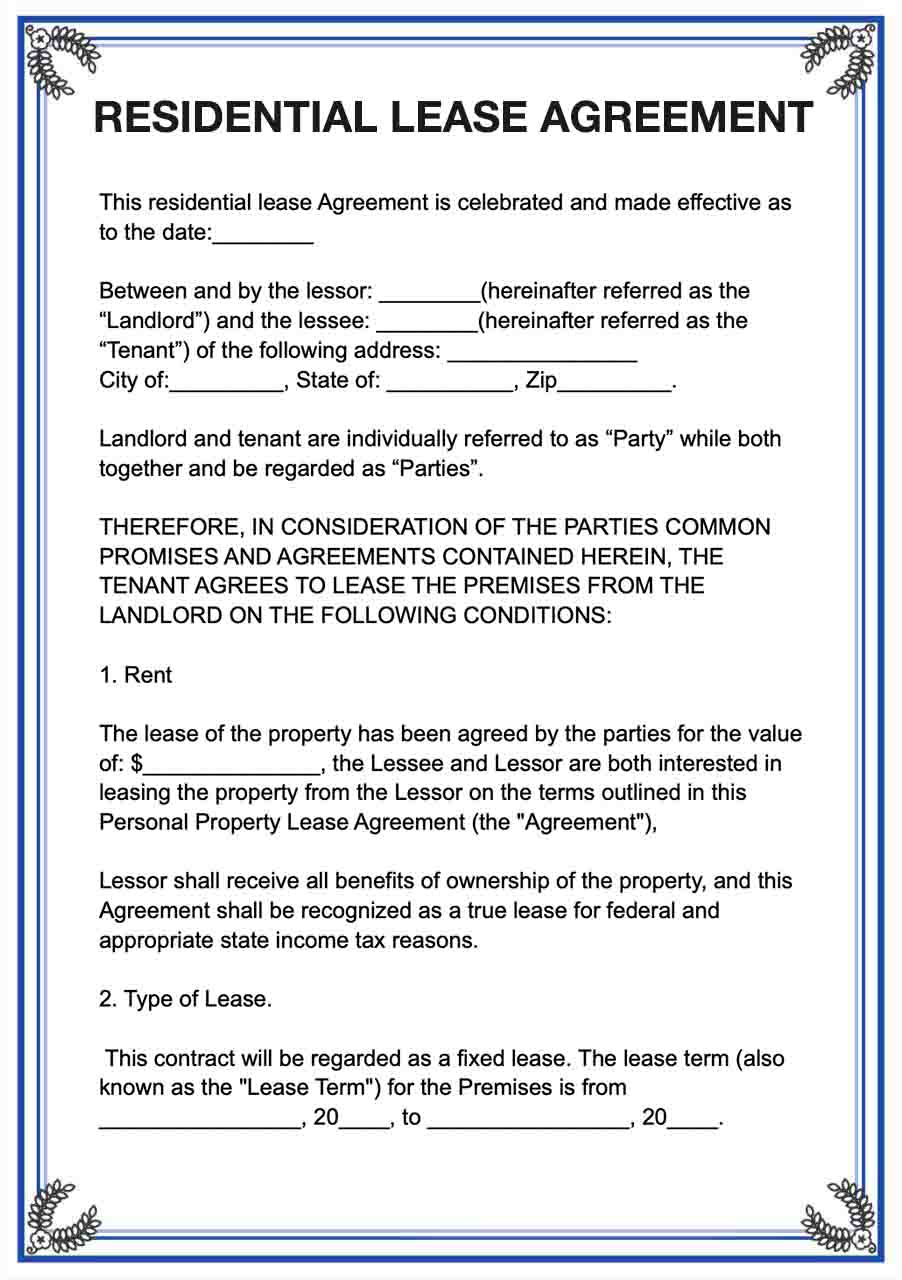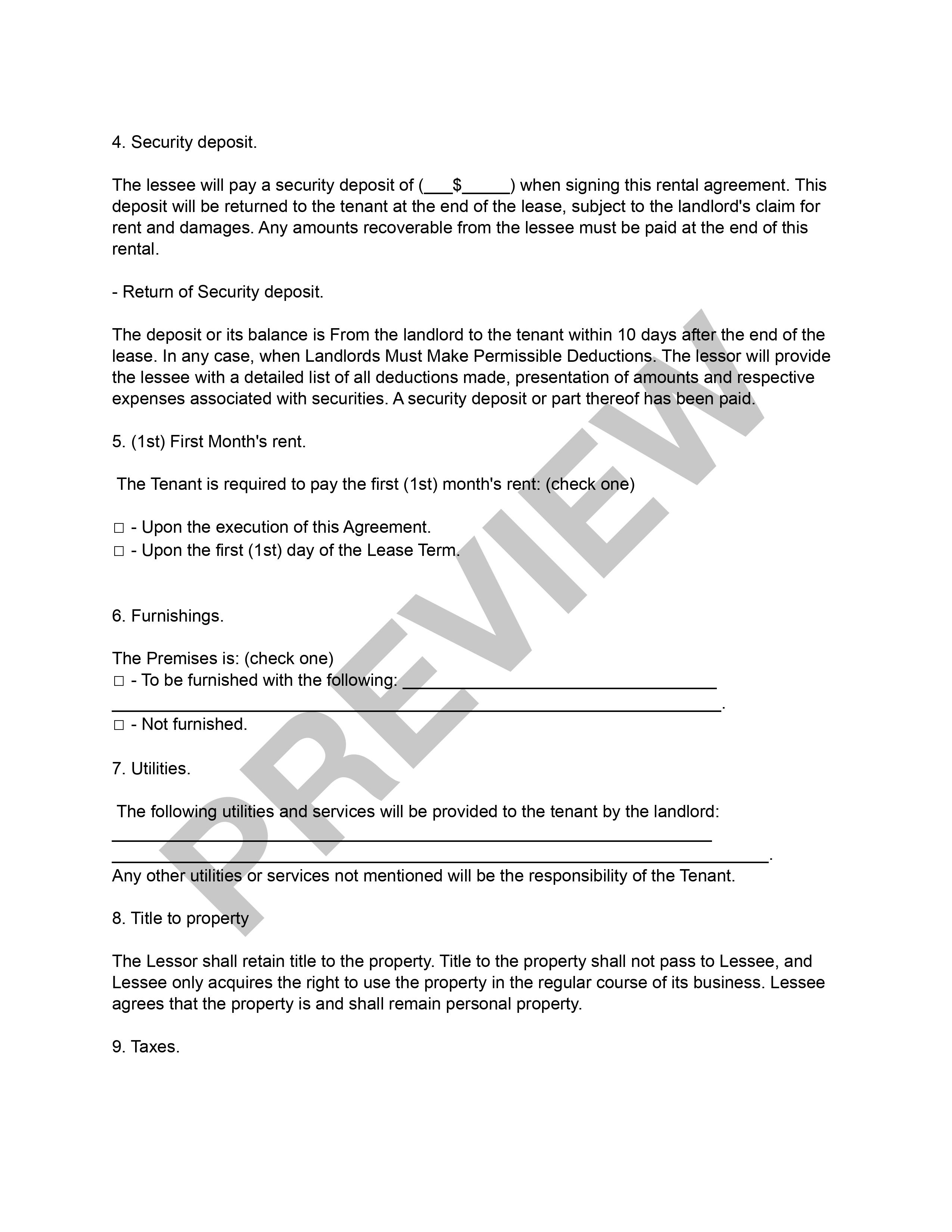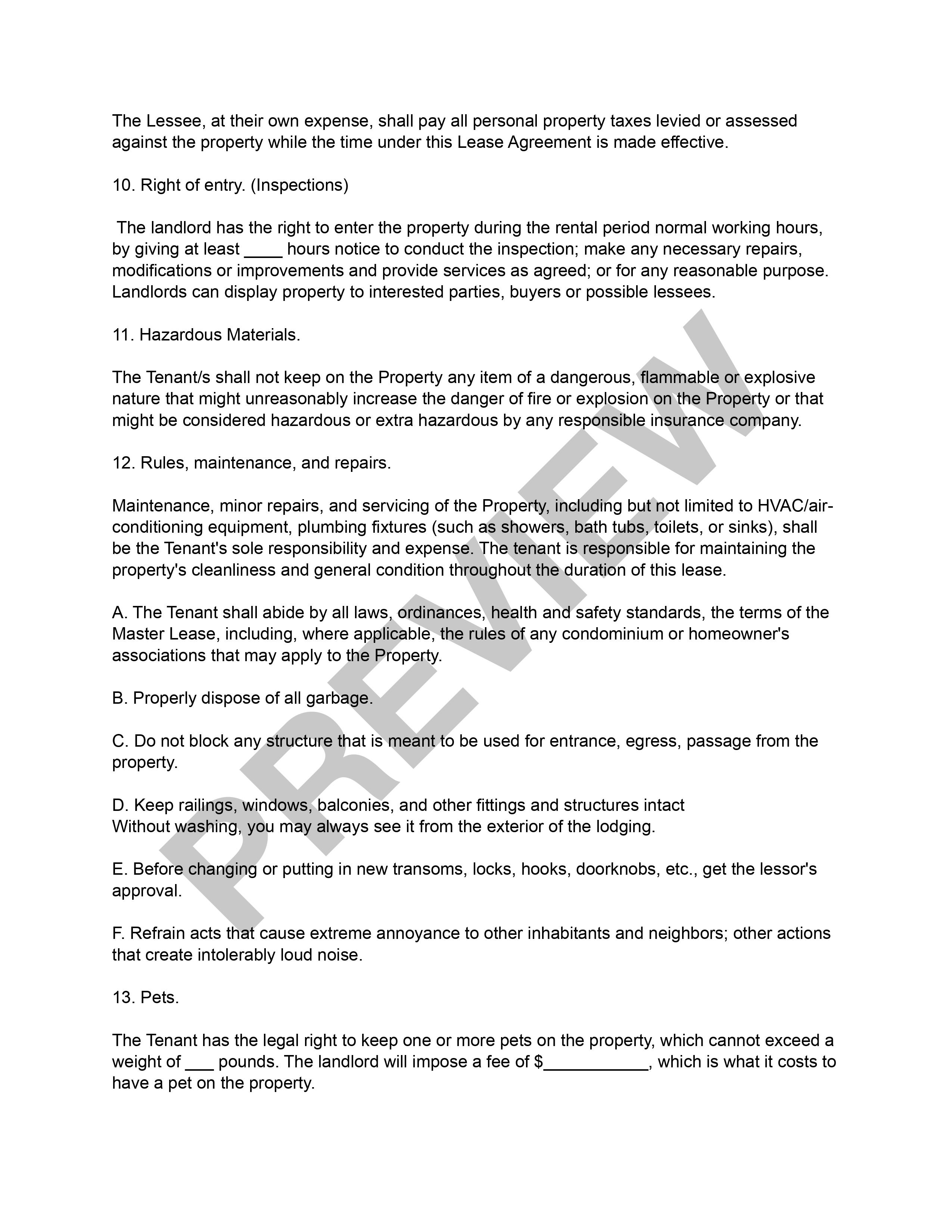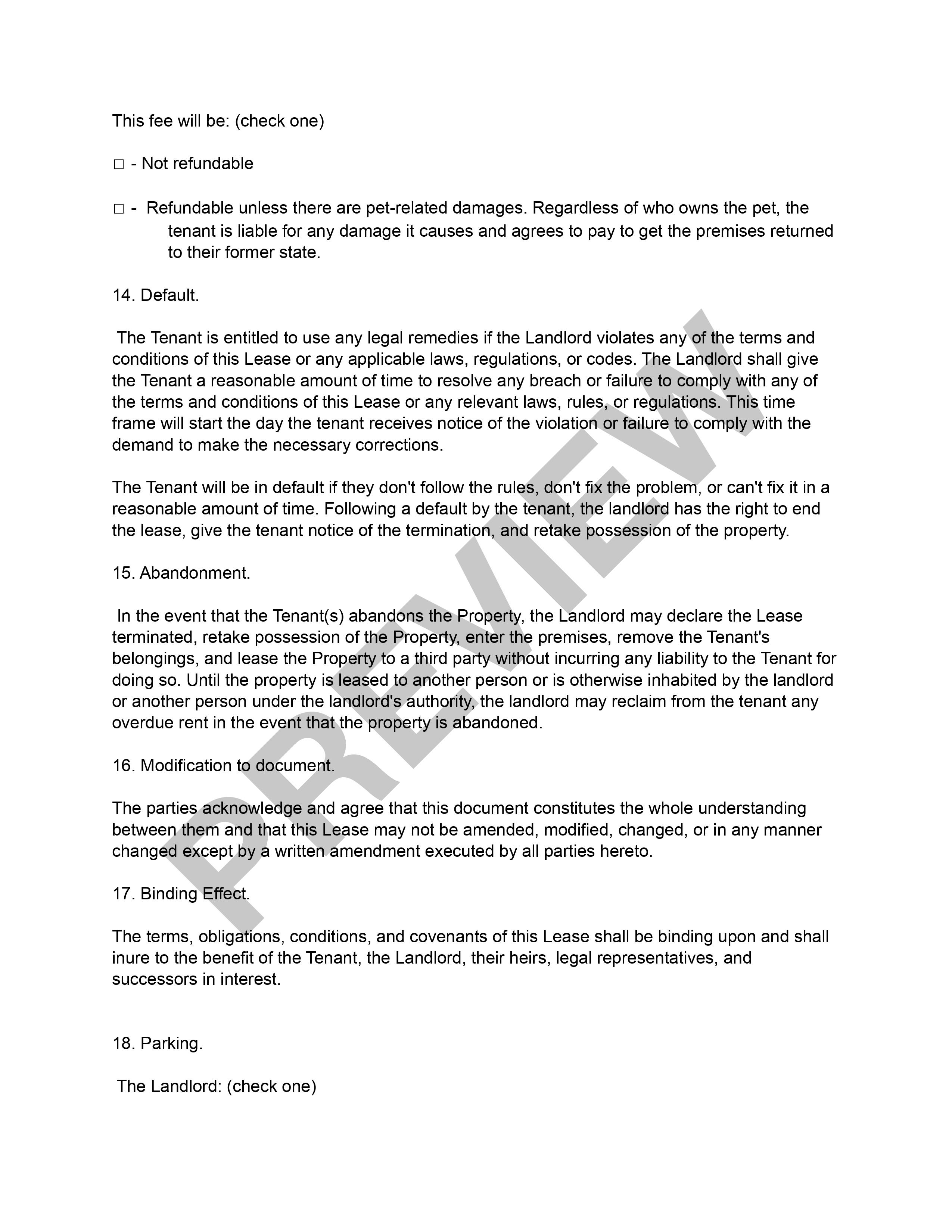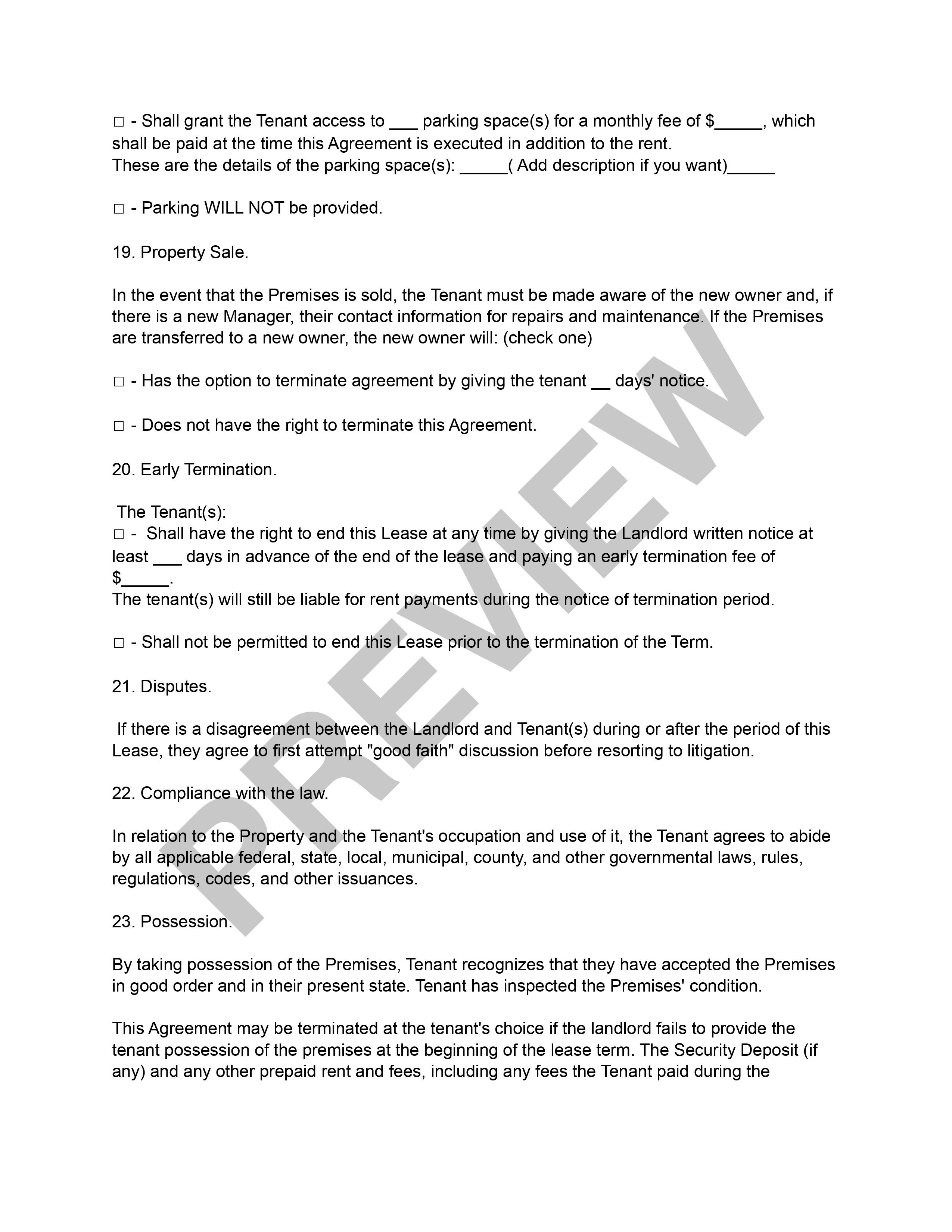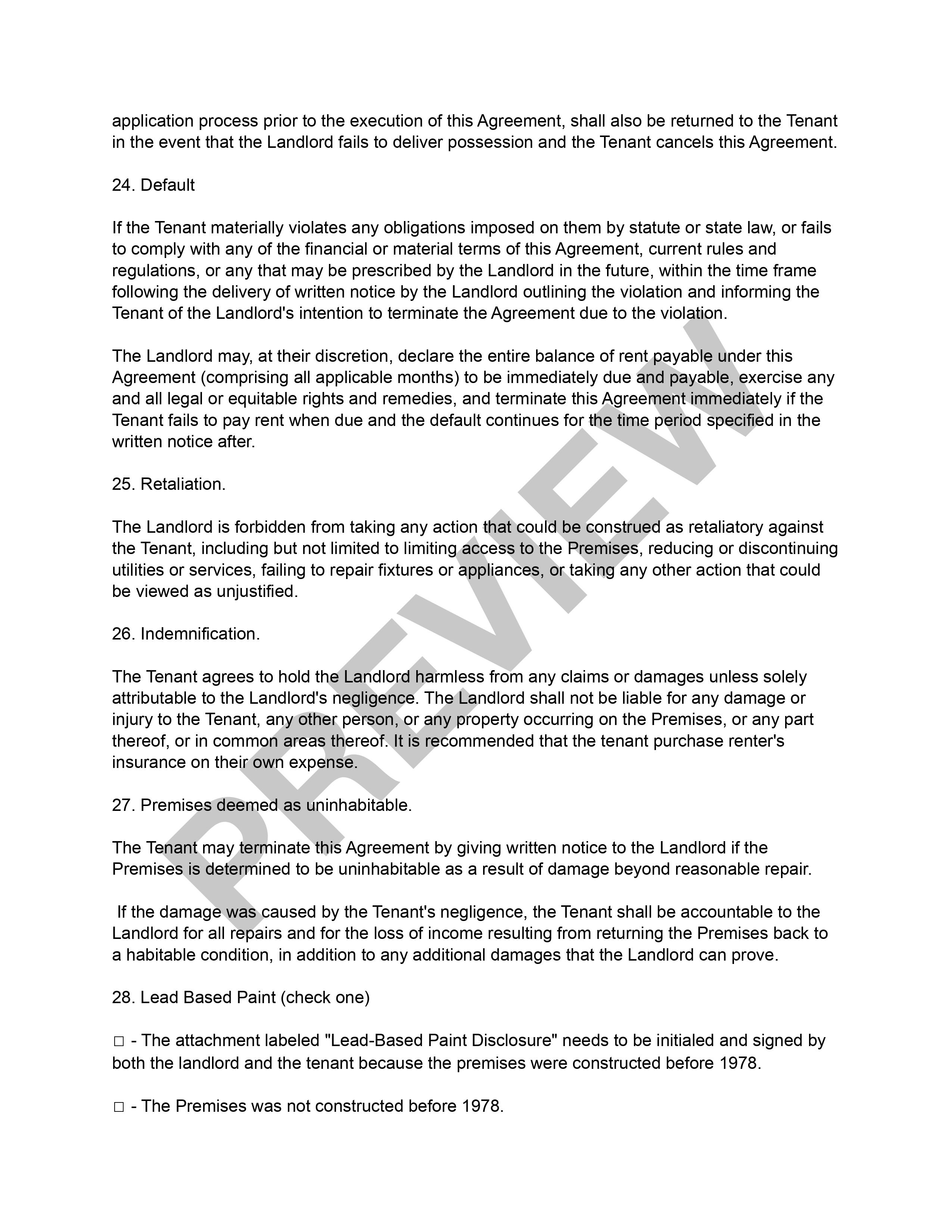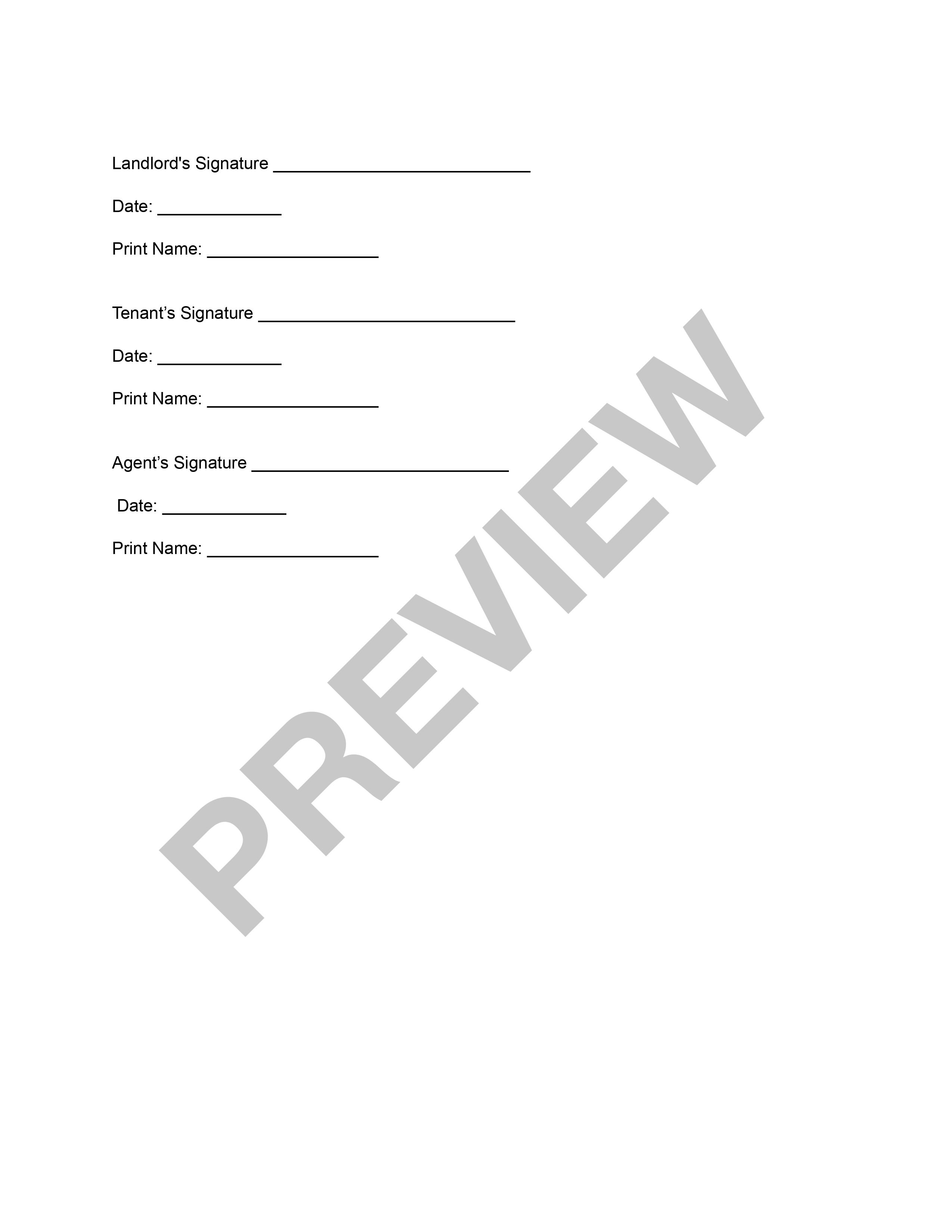Generate Rental / Lease Agreement
A rental agreement is a contract between a landlord and tenant outlining the terms and conditions of rental property use.
What type of property is being rented?
Select one option belowLast Updated February 2023
What is a Lease Agreement?
A lease agreement is a legally binding contract between a landlord and a tenant that outlines the terms and conditions of a rental property. It sets out the rules and expectations for the use of the property, the length of the lease term, the amount of rent to be paid, and other important details such as the security deposit, late fees, and restrictions on pets, smoking, or alterations to the property.
Lease agreements are designed to protect both the landlord and the tenant by ensuring that each party knows their rights and responsibilities under the terms of the lease. They are typically signed by both parties before the tenant moves into the rental property, and they serve as a reference document throughout the tenancy. If either party violates the terms of the lease agreement, it can be used as evidence in legal proceedings or to justify eviction.
What is the duration of the lease?
Tenants often want to know how long they will be committed to the property, while landlords want to know that their property will be occupied for a certain amount of time. On agreements designed by us this is a key step that will be considered and specified on the document.
The duration of a lease is the length of time for which the lease agreement is valid. The duration of the lease is typically specified in the lease agreement and can vary depending on the needs and preferences of the landlord and tenant.
The most common lease duration is one year, but leases can be for shorter or longer periods of time, such as six months or two years. In some cases, the lease may be a month-to-month agreement, which means that the lease is automatically renewed each month unless one party provides notice of termination.
The duration of the lease is an important consideration for both landlords and tenants. For landlords, longer lease terms can provide more stability and reduce the need for frequent tenant turnover, while shorter lease terms can offer more flexibility and allow for changes to the rental property or rental rate. For tenants, longer lease terms can provide more security and stability, while shorter lease terms can offer more flexibility and the ability to move more easily.
When signing a lease agreement, it is important for both the landlord and tenant to carefully review and understand the duration of the lease and any associated terms and conditions, such as the notice required to terminate the lease or renew the lease for another term.
How much is the rent, and how often is it due?
Tenants need to know how much they will be paying, while landlords want to ensure that they are receiving a fair rental rate. The value of the rent along with payment date will be specified on our Agreements.
The amount of rent and the frequency of payment are typically specified in the lease agreement, and can vary depending on the rental market and the needs and preferences of the landlord and tenant.
The amount of rent is typically a fixed amount that is due on a monthly basis, although it may be due weekly, biweekly, or in some other frequency as agreed upon by the landlord and tenant. The rent amount may be subject to increase at the end of each lease term or in accordance with the terms of the lease agreement.
The frequency and due date of rent payments should be clearly outlined in the lease agreement, along with any late fees or penalties that may be incurred if the rent is not paid on time. It is important for tenants to understand the terms of their lease agreement and to make timely rent payments in order to avoid any negative consequences or legal action by the landlord.
If a tenant has any questions or concerns about the amount or frequency of rent payments, they should discuss these issues with the landlord before signing the lease agreement to ensure that both parties are in agreement and have a clear understanding of the terms of the lease.
How is the security deposit handled?
Tenants want to know how much they will need to pay, and when they can expect to receive it back after they move out. Landlords want to ensure that the property is protected against any damages that might occur.
The security deposit is a sum of money that a tenant pays at the beginning of a lease term to protect the landlord from any damages or losses that the tenant may cause during their tenancy. The security deposit is typically handled in a specific way, as required by law, and the terms of its handling should be outlined in the lease agreement.
The most common way that a security deposit is handled is that it is held by the landlord in a separate account, often an interest-bearing account, and returned to the tenant at the end of the lease term, provided that the tenant has fulfilled all of their obligations under the lease agreement and has not caused any damage to the rental property beyond normal wear and tear.
If the landlord intends to deduct any amount from the security deposit to cover any unpaid rent, damages or cleaning costs, the landlord must provide the tenant with an itemized list of the deductions and the remaining balance of the security deposit, usually within a specific timeframe as required by law.
The specific rules and regulations surrounding the handling of security deposits can vary by state and locality, so it is important for both landlords and tenants to understand the requirements that apply to their specific situation.
When signing a lease agreement, it is important for both the landlord and tenant to clearly understand the terms of the security deposit handling and to make sure that the lease agreement reflects these terms accurately.
What are the responsibilities of the landlord and the tenant?
Both parties need to know what their obligations are under the agreement, such as who is responsible for maintenance and repairs, and what the rules are for using the property. All Obligations will be written in detail on Lease/ Rental agreements built by Documentify to ensure satisfaction on both parties.
In a lease agreement, both the landlord and the tenant have certain responsibilities that they must fulfill in order to maintain a safe and habitable living environment. Here are some of the key responsibilities for both parties:
Landlord Responsibilities:
- Provide a safe and habitable living environment.
- Ensure that the rental property is in compliance with local health and safety codes.
- Make necessary repairs and maintain the property in good condition.
- Provide reasonable notice before entering the rental unit.
- Respect the tenant's right to privacy and quiet enjoyment of the property.
- Return the security deposit, minus any necessary deductions, at the end of the lease term.
Tenant Responsibilities:
- Pay rent on time and in full.
- Keep the rental unit clean and in good condition.
- Report any necessary repairs or maintenance to the landlord in a timely manner.
- Follow any rules or regulations specified in the lease agreement or building policies.
- Respect the landlord's property and avoid causing any damage.
- Give reasonable notice before moving out at the end of the lease term.
It is important for both the landlord and the tenant to fully understand their respective responsibilities before signing a lease agreement. If either party fails to fulfill their responsibilities, it can lead to legal disputes or a breach of the lease agreement.
What happens if the tenant wants to break the lease early?
Tenants might want to know what their options are if they need to move out before the lease is up, while landlords want to know what their rights are in this situation.
If a tenant wants to break the lease early, it can have significant legal and financial consequences, as the lease agreement is a legally binding contract between the landlord and tenant. The specific consequences can vary depending on the terms of the lease agreement and local laws, but generally, the following options may be available:
- Pay the Remaining Rent: The tenant may be required to pay the remaining rent for the entire lease term. This is often the case if the lease agreement does not include an early termination clause, or if the clause requires payment of rent until a new tenant is found.
- Find a Replacement Tenant: The tenant may be allowed to find a replacement tenant to take over the lease. This is often called "subletting" or "assigning" the lease. However, the landlord must approve the replacement tenant, and the original tenant is still responsible for paying the rent if the replacement tenant does not fulfill their obligations.
- Negotiate with the Landlord: The tenant may be able to negotiate with the landlord to reach an agreement on the terms of breaking the lease. For example, the landlord may agree to allow the tenant to break the lease if they pay a portion of the remaining rent or forfeit the security deposit.
- Default on the Lease: If the tenant simply moves out without paying the remaining rent or finding a replacement tenant, the landlord may take legal action to recover the unpaid rent or damages to the property. This can result in a negative mark on the tenant's credit report and a court judgment against them.
It is important for tenants to carefully review the lease agreement before signing and to understand the consequences of breaking the lease early. If a tenant is considering breaking the lease early, it is recommended that they consult with a legal professional to fully understand their options and obligations.
What is the policy on pets, smoking, and other potential issues?
Tenants might have questions about whether they can have pets or smoke in the property, while landlords want to ensure that their property is protected against damage and that other tenants are not disturbed.
The policies regarding pets, smoking, and other potential issues in a lease agreement will vary depending on the specific agreement and the preferences of the landlord or property manager.
Some landlords may allow pets in the rental property, while others may have restrictions on the types or number of pets allowed or may require additional deposits or fees. It is important for tenants to carefully review the lease agreement to understand the pet policy and any associated fees or requirements.
Regarding smoking, many rental properties now have a no-smoking policy in place, due to the potential health risks of secondhand smoke and the difficulty of removing smoke odors from a rental property. Tenants should be aware of any smoking policies in the lease agreement and understand the consequences of violating those policies.
Other potential issues that may be addressed in a lease agreement include noise restrictions, maintenance responsibilities, and rules regarding guests and subletting. Again, the specifics of these policies will depend on the individual lease agreement and the preferences of the landlord or property manager. It is important for tenants to read and understand the lease agreement before signing it to ensure that they are comfortable with all of the policies and requirements outlined in the agreement.
Frequently Asked Questions
A lease agreement can be for any length of time that is agreed upon by the landlord and tenant, but the most common terms are 6 months or 1 year.
Shorter lease terms, such as 6 months, can offer flexibility for tenants who are unsure how long they will need to stay in the rental property. However, shorter terms may require more frequent renewals or re-negotiation of terms, which can be time-consuming and potentially costly.
Longer lease terms, such as 1 year or more, can provide more stability and predictability for both landlords and tenants. Longer leases can also offer cost savings in terms of reduced administrative costs associated with frequent lease renewals. However, longer lease terms can limit the tenant's flexibility if their circumstances change and they need to move out before the end of the lease term.
Ultimately, the length of the lease agreement should be determined by the needs and preferences of both the landlord and tenant, and should take into account factors such as the rental market, the location and condition of the property, and the financial goals of both parties.
A lease agreement can be changed, but any changes must be agreed upon by both the landlord and tenant. Any changes to the agreement should be made in writing and signed by both parties to make the changes legally binding.
If the landlord and tenant want to make changes to the lease agreement, they should discuss the proposed changes and come to an agreement. They can then document the changes by creating an addendum to the original lease agreement that outlines the revised terms and conditions. The addendum should be signed and dated by both parties, and should be kept as part of the lease agreement.
It is important to note that any changes to a lease agreement should be made carefully and thoughtfully, as they can have significant legal and financial implications. It is recommended that both the landlord and tenant seek legal advice before making any changes to the lease agreement to ensure that the revised terms are legally sound and protect their respective interests.
A lease agreement is a legally binding contract between a landlord and a tenant that outlines the terms and conditions of a rental property. The following are some key items that should be included in a lease agreement:
- Names and contact information of the landlord and tenant: This identifies the parties to the agreement.
- Property description: This should include the address of the rental property and any other relevant details, such as the unit number, building number, or floor.
- Term of the lease: This specifies the start and end dates of the lease agreement, as well as the conditions under which the lease can be renewed or extended.
- Rent payment information: This outlines the amount of rent that is due, when it is due, and how it should be paid.
- Security deposit: This outlines the amount of the security deposit required and the terms under which it will be returned to the tenant.
- Tenant's responsibilities: This outlines the tenant's responsibilities, such as paying rent on time, keeping the property clean, and not damaging the property.
- Landlord's responsibilities: This outlines the landlord's responsibilities, such as maintaining the property, making necessary repairs, and respecting the tenant's privacy.
- Pet policy: This outlines any restrictions on pets, including breed, size, and number.
- Subleasing policy: This outlines whether the tenant is allowed to sublease the property or not.
- Termination policy: This outlines the conditions under which either party can terminate the lease agreement early.
- Rules and regulations: This outlines any rules or regulations that the tenant must follow while occupying the property, such as noise restrictions, smoking policies, or restrictions on alterations to the property.
It is important that both the landlord and the tenant read and understand the lease agreement before signing it.
Rent can be paid in different ways depending on the terms of the lease agreement and the preferences of the landlord and tenant. The following are some common ways in which rent is paid:
- Check or money order: This is one of the most common methods of rent payment. The tenant writes a check or obtains a money order and delivers it to the landlord, either in person or by mail.
- Cash: Some landlords may accept cash payments for rent, although this method of payment can be risky for both parties and is generally not recommended. It is important for the tenant to obtain a receipt for any cash payments made.
- Bank transfer: Some landlords may accept rent payments via bank transfer or electronic funds transfer (EFT), in which the tenant transfers the rent amount directly to the landlord's bank account.
- Online payment: Many landlords now accept rent payments online through various payment processing services or through their own website.
It is important to note that the terms of the lease agreement should specify the acceptable forms of rent payment and the due dates for each payment. Tenants should make sure that they understand the payment terms and are able to make payments on time to avoid late fees or other penalties.
If a tenant breaks a lease agreement by moving out before the end of the lease term or by violating any of the terms and conditions of the lease, the landlord may have the right to take legal action to recover any damages or losses incurred as a result of the tenant's actions. The following are some of the consequences that a tenant may face if they break a lease agreement:
- Early termination fee: The lease agreement may require the tenant to pay a fee if they move out before the end of the lease term. This fee is intended to compensate the landlord for the costs associated with re-renting the property.
- Loss of security deposit: If the tenant causes damage to the rental property or fails to pay rent, the landlord may be entitled to withhold some or all of the tenant's security deposit to cover the costs of repair or unpaid rent.
- Legal action: If the tenant breaches the lease agreement, the landlord may be able to take legal action to recover any damages or losses incurred as a result of the tenant's actions. This may include filing a lawsuit to recover unpaid rent or damages to the rental property.
- Negative rental history: If the tenant breaks the lease agreement, it may be reported to credit bureaus, which can negatively impact the tenant's credit score and make it more difficult for them to rent in the future.
It is important for both landlords and tenants to understand the consequences of breaking a lease agreement, and to try to resolve any issues or disputes in a mutually beneficial way before resorting to legal action.
